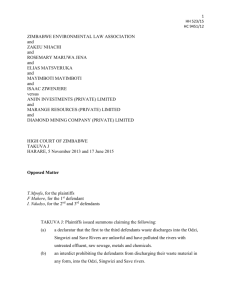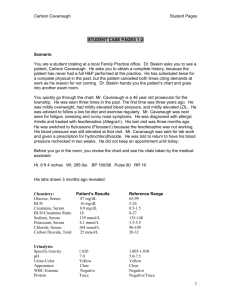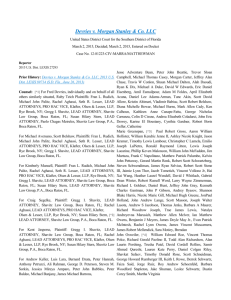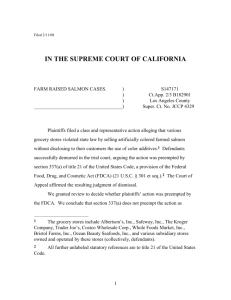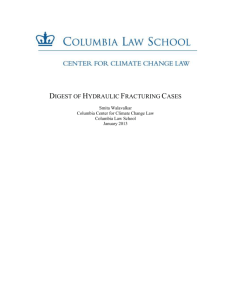A Class Action must be Preferable for Systemic Abuse Cases
advertisement
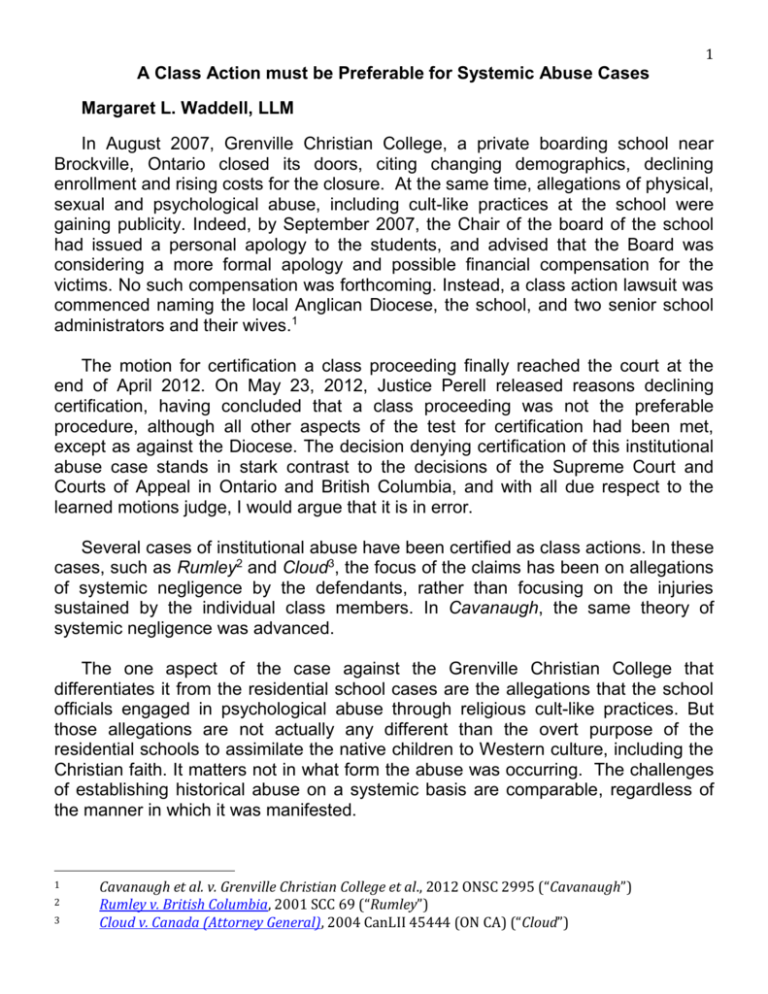
1 A Class Action must be Preferable for Systemic Abuse Cases Margaret L. Waddell, LLM In August 2007, Grenville Christian College, a private boarding school near Brockville, Ontario closed its doors, citing changing demographics, declining enrollment and rising costs for the closure. At the same time, allegations of physical, sexual and psychological abuse, including cult-like practices at the school were gaining publicity. Indeed, by September 2007, the Chair of the board of the school had issued a personal apology to the students, and advised that the Board was considering a more formal apology and possible financial compensation for the victims. No such compensation was forthcoming. Instead, a class action lawsuit was commenced naming the local Anglican Diocese, the school, and two senior school administrators and their wives.1 The motion for certification a class proceeding finally reached the court at the end of April 2012. On May 23, 2012, Justice Perell released reasons declining certification, having concluded that a class proceeding was not the preferable procedure, although all other aspects of the test for certification had been met, except as against the Diocese. The decision denying certification of this institutional abuse case stands in stark contrast to the decisions of the Supreme Court and Courts of Appeal in Ontario and British Columbia, and with all due respect to the learned motions judge, I would argue that it is in error. Several cases of institutional abuse have been certified as class actions. In these cases, such as Rumley2 and Cloud3, the focus of the claims has been on allegations of systemic negligence by the defendants, rather than focusing on the injuries sustained by the individual class members. In Cavanaugh, the same theory of systemic negligence was advanced. The one aspect of the case against the Grenville Christian College that differentiates it from the residential school cases are the allegations that the school officials engaged in psychological abuse through religious cult-like practices. But those allegations are not actually any different than the overt purpose of the residential schools to assimilate the native children to Western culture, including the Christian faith. It matters not in what form the abuse was occurring. The challenges of establishing historical abuse on a systemic basis are comparable, regardless of the manner in which it was manifested. 1 2 3 Cavanaugh et al. v. Grenville Christian College et al., 2012 ONSC 2995 (“Cavanaugh”) Rumley v. British Columbia, 2001 SCC 69 (“Rumley”) Cloud v. Canada (Attorney General), 2004 CanLII 45444 (ON CA) (“Cloud”) 2 In his decision on certification, Justice Perell conceded that he was bound by the higher court decisions in Cloud, Rumley and Slark,4 with respect to the common issues requirement, and found there were common issues as to whether the defendants owed and breached either a duty of care or fiduciary duty to the Class.5 Similar issues were certified in the residential school abuse cases. Justice Perell was reluctant to certify these common issues, as he was of the view that they actually lacked in commonality “principally because, in my opinion, the resolution of the proposed common issues would not avoid duplication of fact-finding or legal analysis.”6 In his view, asserted without explanation, the evidence and legal analysis from the common issues trial would have to be repeated in proving individual causation and damages. Here is where the motions judge made his first in a series of analytical errors, which lead to his finding that this case should be distinguished from Cloud, and that a class action was not the preferable procedure. However, for the purposes of the common issues analysis, Justice Perell did concede that he was bound by the higher courts’ rulings, including the general admonition from the Court of Appeal in Cloud, that “an issue can constitute a substantial ingredient of the claims and satisfy s. 5(1)(c) even if it makes up a very limited aspect of the liability question and even though many individual issues remain to be decided after its resolution.”7 Justice Perell commenced his preferable procedure analysis, by misstating the test for preferable procedure as including the issue of whether the class proceeding would be better than other methods of “resolving the dispute.”8 That is, of course, not the test at all. As s. 5(1)(d) of the Class Proceedings Act, 1992 states, and the Supreme Court decision in Hollick explains, the issue is whether “a class proceeding would be the preferable procedure for the resolution of the common issues,” taking into account the importance of the common issues in relation to the claims as a whole. 9 The issue is not whether answering the common issues will lead to resolution of the entire dispute. Rather, the question for the court to determine is whether a class action is a fair, efficient and manageable method of advancing the claim, taking into consideration the common issues in their context. 10 The preferability requirement in s. 5(1)(d) of the CPA can be met even where there are substantial individual issues that remain to be determined at individual hearings. So Slark (Litigation Guardian of) v. Ontario, 2010 ONSC 1726 (S.C.J.), leave to appeal ref’d., 2010 ONSC 6131 (Div. Ct.) 5 Cavanaugh, supra, at para. 121, 122, 132 6 Cavanaugh, at para. 129 7 Cloud, supra, at para. 53 8 Cavanaugh, supra, at para. 145 and 146 9 Hollick v. Toronto (City), 2001 SCC 68, [2001] 3 S.C.R. 158, at para. 29, 30 10 Cloud, supra, at para. 74 4 3 long as the answers to the common issues will significantly advance the action as a whole, then the preferability test will be met. In concluding that a class action was not the preferable procedure, Justice Perell accepted the defendants’ arguments that the plaintiffs would have to “replicate the fact-finding and legal analysis of the common issues trial.”11 This completely misses the point of the class proceeding. The findings of fact and law determined at the common issues trial are then binding on the parties, and form part of the record for the individual issues trials. There is no need, at all, to revisit the issues of systemic negligence when the class members present their cases to prove individual causation and damages. The table is already set with the findings of the school’s breach of duty of care and/or breach fiduciary duty. It will only remain for the individual to establish that the breach(es) caused or contributed to the class members’ individual damages. Justice Perell suggests that proof of systemic negligence will make proof of the individuals’ claims more difficult, and will impede access to justice. He does not explain how this is so, and the example he advances at paragraph 158 of his Reasons does nothing to shed light on why the allegations of systemic negligence will actually make the individual claims more difficult. If the plaintiffs are able to establish their allegation that it was a systemic breach of the defendants’ duty of care to inflict psychological abuse, including to “indoctrinate students in the fanatical teachings of the Community of Jesus,”12 (a much more serious allegation than the tempered language of “the school’s adoption of Mother Cay’s and Mother Judy’s teachings” as Justice Perell frames the allegation, above) then it only remains for the individual plaintiffs to establish how this indoctrination damaged them, personally. The difficulty in the plaintiffs’ case will be in establishing systemic negligence and breach of fiduciary duty. But, should they succeed, there will be nothing more onerous or difficult about proving causation and damages in this case than in Cloud. In stark contrast to Cloud, Justice Perell concluded that the plaintiffs’ complaints should proceed as individual, jointly case managed actions, which was not an option argued for by the parties. However, case managing many individual actions does not promote judicial economy, nor will it result in any procedural benefits to the defendants. Nor will it promote access to justice. This case is not analogous to the Hudson v. Austin case Justice Perell cites as an example of proceeding effectively with multiple claims against the same defendant.13 That case was a case of medical 11 12 13 Cavanaugh, supra, at para. 152, 159, 172 ibid, at para. 22, 70 ibid, at para. 163 - 171 4 malpractice where the plaintiffs’ counsel conceded that the case was not appropriate for certification, but they was prepared to act on a contingency retainer for the 99 affected individuals. In Cavanaugh, there is no evidence of any such concession in the Reasons, and no evidence that the class’ claims could or would be taken on by class counsel on an individual contingency retainer. Furthermore, the Class Proceedings Fund funded the claim. The Reasons do not suggest that there was any evidence before the court that individual class members would be prepared to assume the risks of a negative costs award — a risk from which they are protected by the Fund. Hence, compelling the class to pursue individual claims will be entirely antithetical to the goals of judicial economy and access to justice. It appears that Cavanaugh is in all respects comparable to Cloud. In both cases, the plaintiffs allege systemic abuses in the manner in which the schools were operated. Those issues focus on the conduct of the defendants, and the scope of their duty of care to a class of children left under their care. Both actions, in my view, should be certified as class actions for the same reasons.







